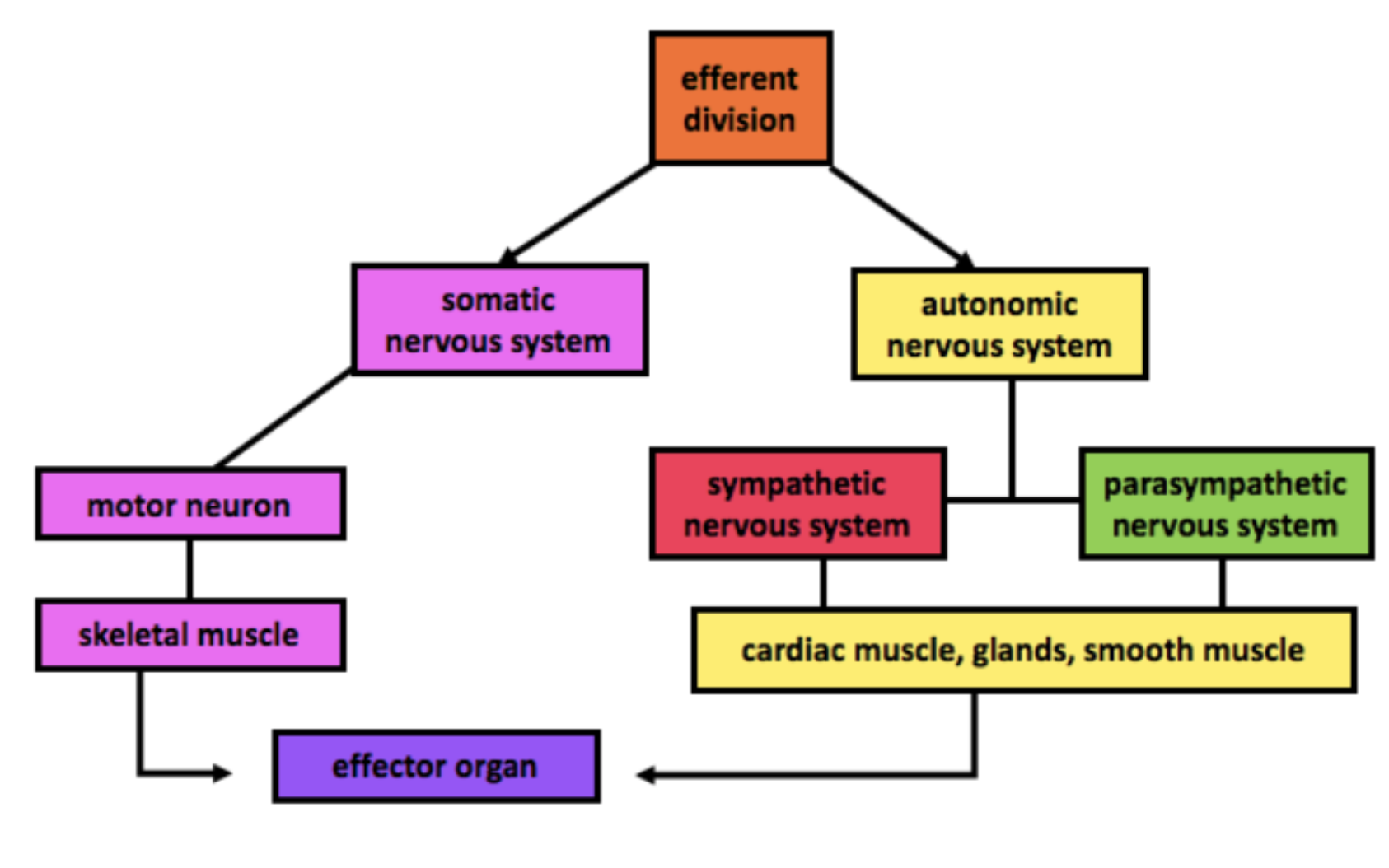Main Body
22. Agents and Actions of the Autonomic Nervous System: Sympathetic Nervous System
Sympathetic Nervous System
Sympathetic Nervous System [SNS] – “fight or flight”
The SNS can also be thought of as the “E division” – embarrassment, emergency, exercise, excitement
What do you want your body to do when in fight or flight situation?
- Alertness
- Bronchodilation – increased oxygen necessary for brain and muscles to function well
- Blood shunted to organs and muscles – need organs and muscles to function well
- Decreased digestion – body does not need to exert energy on digestion in emergency
- Increased cardiac output – improved blood and oxygen delivery
- Production of energy (fatty acid release, glycogenolysis) – important for muscles to perform
- Prevention of waste elimination – body does not need to exert energy on elimination in emergency
- Sweat – help maintain homeostasis
EXCEPTIONS – most blood vessels and all sweat glands only have sympathetic innervation
Sympathetic Neurons
Pre-ganglionic sympathetic neurons release acetylcholine [ACh] and post-ganglionic sympathetic neurons release norepinephrine [NE]. ACh will then go onto stimulate the post-ganglion sympathetic neurons at muscarinic receptors releasing NE and then NE will go onto stimulate adrenoceptors located on a variety of effector organs and tissue such as cardiac muscle, smooth muscle, and glands.
EXCEPTIONS – acetylcholine [ACh] is released by post-ganglionic sympathetic neurons innervating sweat glands, which means ACh receptors (as opposed to adrenoceptors) have to be blocked in order to decrease sweating as
Norepinephrine
Norepinephrine [NE] interacts with two types of receptors:
- Alpha-adrenergic receptors [alpha adrenoceptors]
- Alpha-1 – blood vessels
- Alpha-2 – CNS (presynaptic)
- Beta-adrenergic receptors [beta adrenoceptors]
- Beta-1 – heart
- Beta-2 – lungs
- Beta-3 – bladder
Physiological Effects of SNS on Organs/Tissue & Respective Receptors
| Organ/Tissue | Receptor Subtype | Physiological Effect | |
|---|---|---|---|
| BLADDER – smooth muscle | Beta-3 | relaxes | prevents urination |
| BLADDER – sphincter | Beta-3 | contracts | prevents urination |
| EYE – ciliary muscle | no SNS innervation | relaxes | improves far-sighted vision |
| EYE – pupil | Beta- | dilation/relaxation | mydriasis |
| GASTROINTESTINAL – glands | Beta-2 | inhibits secretion | prevents digestion |
| GASTROINTESTINAL – smooth muscle | Alpha-2 Beta-2 |
relaxes smooth muscle | prevents digestion |
| GASTROINTESTINAL – sphincter | Alpha-1 | contracts | prevents defecation |
| HEART – AV node | Beta-1 | increased conduction | |
| Heart – cardiac muscle | Beta-1 | increased contractility | positive ionotropic effect – enhances blood delivery |
| Heart – cardiac output | Beta-1 | increases | enhances blood delivery |
| Heart – SV node | Beta-1 | increased heart rate | positive chronotropic effect – increases oxygen delivery |
| Lung – smooth muscle (bronchioles & trachea) | Beta-2 | dilation/relaxation | enhances breathing |
| Salivary Gland | Beta-2 | stimulates viscous secretions | |
| Sweat Gland | stimulates sweat secretion | regulates body temperature | |
| Vasculature – smooth muscle | Alpha-1 Beta-2 |
contracts relaxes coronary arteries |
shunt blood to vital organs (brain, heart, etc), enhance cardiac output |




